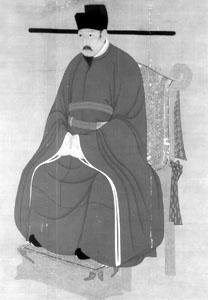
Ancient Icon: This stunning 11th-century portrait of Sung Jen-tsung is one of the Imperial visages on display at the Asian Art Museum.
'Splendors of Imperial China' is, well, splendid
By Zack Stentz
Imagine that the Roman Empire, instead of going the way of the dodo in 476 C.E., had continued on in unbroken succession until the dawn of the 20th century, all the while amassing an art collection that spanned the entire period, and you get an idea of the breathtaking scope of the Chinese nation's cultural treasures now on display at the Asian Art Museum's Spendors of Imperial China exhibit.
Representing more than 4,000 years of art history in calligraphy, sculpture, painting and ornamental objects, the 350 works on display provide a stunningly comprehensive look into China's artistic heritage, making the exhibit both a mecca for Asian art lovers and an ideal introduction for novices wishing to familiarize themselves with the artistic output of the longstanding cultural superpower that is China.
Choosing highlights from such an already cherry-picked collection may be impossible, but to many Western eyes, at least, the paintings and calligraphy from the Sung period (9601279 C.E.) will prove especially appealing, with their refined classicism and lack of excess ornamentation. Subjects of the paintings on display range from mighty emperors and noblemen to cute little kittens and comical-looking chickens. "Works of this sort are often referred to as being from the 'fur and feathers school' because of the way each hair or feather is individually painted by the artist," said Asian Art Museum marketing director William Goulet of the latter works, barely containing his elation at hosting the exhibition.

Soothing the Savage Beast: Delicately carved from bamboo, "The tiger-taming lohan" reveals the artistry of Chinese wood sculpture.
Photo by Bruce White
It's also fun spotting the foreign influences on various phases of the Chinese art on display, from the almost Tibetan appearance of many of the Buddhist devotional works to the Islamic-oriented geometric patterns from the Near East introduced during the Mongol-ruled period of the Yuan dynasty (12721368 C.E.). And if some of the Ming dynasty (13681644 C.E.) ceramic objects bring to mind the mosaics at the Hagia Sophia in Istanbul, it's no coincidence, because the intricate blue patterns reveal the influence of the late Byzantine aesthetic on the Chinese artists of the period.
All the works on display remain in astonishingly good condition, especially given the collection's history as a political football in China's many modern tribulations. Once the property of successive imperial dynasties, the collection was seized by China's Nationalist Kuomintang movement in 1924 after the last Ching dynasty emperor, P'u Yi (of Bertolucci's Last Emperor fame), was overthrown and forced out of Beijing's forbidden city. And from 1931 until 1945, the works were boxed up and carried by truck, donkeyback and sampan from one end of China to the other in a successful bid to protect them from the invading Japanese, then evacuated in 1949 to Taiwan just ahead of Mao's Communists.
Now ensconced in Taipei's National Palace Museum, the collection is rightfully a source of national pride to the Taiwanese and only rarely leaves the island. The current exhibit was debated fiercely in the Taiwanese parliament, with many patriotic members arguing that the works should not leave the nation at all, given their huge cultural importance to the Chinese people.
Luckily for American viewers, cooler heads prevailed. The works--minus a few particularly fragile or iconic pieces--were eventually allowed to leave the country. Already shown at the Metropolitan Museum of Art in New York and the Art Institute of Chicago, the works will move from the Asian Art Museum for a showing at the National Gallery in Washington, D.C., before returning to Taiwan in April 1997.
And though the 350 works on display represent only a tiny fraction of the total collection (over 600,000 pieces and growing), they've been well selected to show the magnitude and variety of Chinese artistic achievement, and besides, they're certainly a lot cheaper to see than hopping on the next Boeing 747 to Taipei.
Through Dec. 8 at the Asian Art Museum, Golden Gate Park. Tue.Sun., 10am4:45pm, Wed. until 8:45 p.m. Wed. $9.50 adults, $7.50 seniors, $6.50 children 1217, free to children under 12 and members. 379-8801.
[ SF Live | MetroActive Central | Archives ]
![[MetroActive Arts]](/arts/gifs/art468.gif)